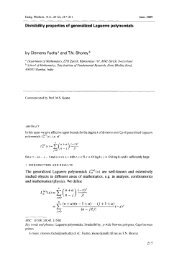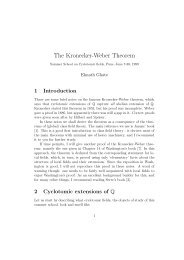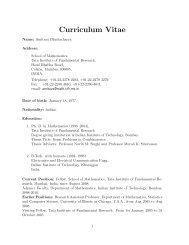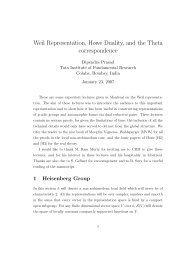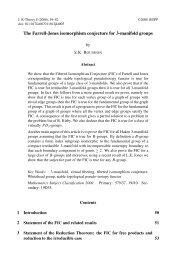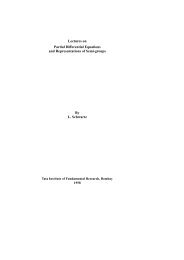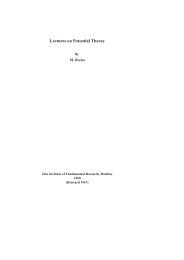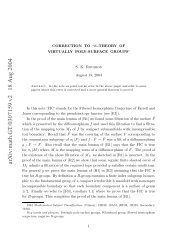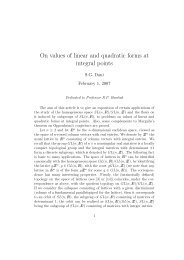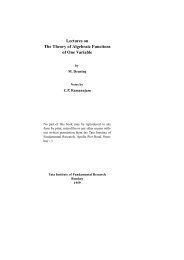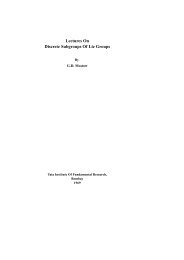Shanta Laishram and T. N. Shoreyand we shall use them without reference. For given k, N and j with 1 j < k, we putLetk−1∏M j (N, k) = (N − j + i).i=0N j (k) := {N ∈ N 1 (41) : P (M j (N, k)) 59}.By observing thatandM 1 (N, k + 1) = M 1 (N, k)(N − 1 + k), M k (N, k + 1) = (N − k)M k−1 (N, k)M j (N, k + 1) = M j (N, k)(N − j + k) = (N − j)M j−1 (N, k) for 1 < j < k,we can compute N j (k) recursively as follows. Recall that P (N(N − 1)) 41 for N ∈ N 1 (41). Hencewe haveN 1 (3) := {N ∈ N 1 (41) : P (N + 1) 59}, N 2 (3) := {N ∈ N 1 (41) : P (N − 2) 59}.For k 3 and 1 j k, we obtain N j (k + 1) recursively byandN 1 (k + 1) := {N ∈ N 1 (k) : P (N − 1 + k) 59}, N k (k + 1) := {N ∈ N k−1 (k) : P (N − k) 59}N j (k + 1) := {N ∈ N j (k) : P (N − j + k) 59} ∪ {N ∈ N j−1 (k) : P (N − j) 59} for 1 < j < k.6. Pro<strong>of</strong> <strong>of</strong> Theorems 3 and 4 for k < 10Let k = 2. Then a 40. By Corollary 2.2 (i), we first restrict to those m for which P (m(m+1)) 41.They are given by m = N − 1 with N ∈ N 1 (41). By Procedure I, we obtain the tuples (n, 2, a) givenby the following table.a n + a a n + a a n + a4, 5 9 4 10 5, 6 28, 49, 644, 8, 9 16, 25, 81 9 33, 45, 55, 100, 121, 243 10 33, 24312 27, 28, 49, 64, 91, 169, 729 13 21, 25, 28, 36, 50, 64 14 2513, 14 81, 126, 225, 2401, 4375 15, 16 289 17 51319, 3318 25, 76, 81, 96, 361, 513, 1216 19 25, 28, 36, 49, 50, 64, 243 20 28, 33, 49, 64, 24321 25, 33, 45, 55, 529 21, 22 46, 81, 100, 121, 576 23 8124 40, 81, 65, 325, 625, 676 26 49, 64 27 49, 64, 78428 81, 145 29 81, 125, 961 31 24332 243, 289, 1089 33 49, 50, 51, 64, 85, 34 49, 50, 64, 81136, 256, 289, 583236 1369 38 65, 81, 325, 625, 676 39 81, 82, 1025, 656140 49, 64, 82, 288Let 3 k 9. Then 10 < a 50 if k = 3, 4 and 30 < a 50 if 5 k 9. Thus we may assumethat P (∆(m, k)) 59 by Corollary 2.2 (i).Let m 10000. We need to consider [k, 59] ∪ M(k) where M(k) = {60 m 10000 :P (∆(m, k)) 59}. We compute M(3) and further from the identity ∆(m, k + 1) = (m + k)∆(m, k),10
<strong>Extensions</strong> <strong>of</strong> Schur’s <strong>irreducibility</strong> <strong>results</strong>we obtain M(k + 1) = {m ∈ M(k) : P (m + k) 59} for k 3 recursively. In fact we obtainM(6) = [{90, 91, 116, 184, 185, 285, 340}, M(7) = {90, 184}and M(8) = M(9) = ∅. We now apply Procedure I on m ∈ [k, 59] ∪ M(k). We obtaina n + a a n + a11 28 12 26, 27, 28, 6519, 20 56, 100 20 46, 16221 46 32 51, 56, 100, 12133 51 38, 39 8241, 43 56, 100 43, 44, 45 162or a ∈ {12, 13, 18, 19, 20, 27, 32, 33, 34, 39, 41, 43, 44}, n + a = 50 if k = 3 anda n + a a n + a a n + a a n + a11, 12 27, 28 13, 31, 32, 33 51 18 57 10 66if k = 4.Thus m > 10000. Suppose that m + j = N ∈ N 1 (41) for some 1 j < k. Then ∆(m, k) =M j (N, k) which imply N ∈ N j (k) since P (∆(m, k)) 59. Let N ′ j (k) = N j(k) ∩ [10000, ∞). We findthatN ′ 1(3) = {13311, 13455, 17576, 17577, 19551, 29601, 32799, 212381}N ′ 2(3) = {10881, 11662, 13312, 13456, 13690, 16170, 17577, 23375, 27456, 31213, 134850, 212382, 1205646}N ′ 1(4) = {17576}, N ′ 2(4) = {17577}, N ′ 3(4) = {10881}and N ′ j (k) = ∅ for k 5 and 1 j < k. We now take m = N − j with N ∈ N j(k) for 1 j < kand apply Procedure I to find that there are no triplets (n, k, a).Thus we may suppose that m + j /∈ N 1 (41) for all 1 j < k. Then P ((m + i)(m + i + 1)) > 41for each 0 i < k − 1. By Corollary 2.2 (i), we may suppose that P (∆(m, k)) 53 for k 8and P (∆(m, k)) 59 for k = 9. Taking V (m, k) = {P ((m + 2i)(m + 2i + 1)) : 0 i < k 2 , wehave V (m, k) ⊆ {43, 47, 53} for 4 k 7 and V (m, k) = {43, 47, 53, 59} if k = 8, 9. Then k ≠ 8and computing {a 50 : a ∈ B{Q 1 , Q 2 } for (Q 1 , Q 2 ) ∈ {(47, 43), (53, 43, (53, 53)} if k = 4, 5;(Q 1 , Q 2 ) = (53, 43) if k = 6, 7, 9, we find that the set is ∅ except when k = 5, (Q 1 , Q 2 ) = (43, 47)where it is {42}. Thus we may assume that k = 5 and a = 42. Further P (∆(m, k)) = 47 and43|∆(m, k). If p|∆(m, k) with 13 p 41, then 42 /∈ B{47, p} by Corollary 2.2 (iii). Thus we mayfurther suppose that p|∆(m, k) implies p 11 or p ∈ {43, 47}. Also P (m) 41 otherwise each <strong>of</strong>P (m), P ((m + 1)(m + 2)), P ((m + 3)(m + 4)) is > 41 which is not possible. Again P (m + 2) 41otherwise each <strong>of</strong> P (m(m + 1)), P (m + 2), P ((m + 3)(m + 4)) is > 41. Therefore P (m(m + 2)) 41implying P (m(m+2)) 11. If m is odd, then m = N −2 for N ∈ N 2 (11) and we check that there isa prime p > 11, p /∈ {43, 47} with P |∆(m, k) which is a contradiction. Thus m is even and we haveP ( m 2 ( m 2 + 1)) 11 implying m = 2N − 2 with N ∈ N 1(11). This is again not possible as above.Let k = 3. Then P (∆(m, k)) 53 by Corollary 2.2 (i). Also P 1 > 41 since m + j /∈ N 1 (41) for1 j < k. Further P ((m + 1)(m + 2)) > 41 if P (m) > 41 and P (m(m + 1)) > 41 if P (m + 2) > 41which are excluded by Corollary 2.2 (iii) as above. Thus we may suppose that P 1 = P (m + 1) > 41and P (m(m + 2)) 41. If m is even, then m = 2N − 2 for N ∈ N 1 (41) and we check thateither P 1 > 53 or a > 50 for a ∈ B{P 1 , P 2 , . . .}. Thus m is odd. If P (m(m + 2)) 31, thenm = N − 2 with N ∈ N 2 (31) and we check that either P 1 > 53 or a > 50 for a ∈ B{P 1 , P 2 , . . .}which is excluded. Thus P 2 = P (m(m + 2)) ∈ {37, 41} which together with 41 < P 1 53 implya > 50 for a ∈ B{P 1 , P 2 } except when P 1 = 43, P 2 = 41 where a = 40 ∈ B{P 1 , P 2 }. Thus11



